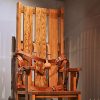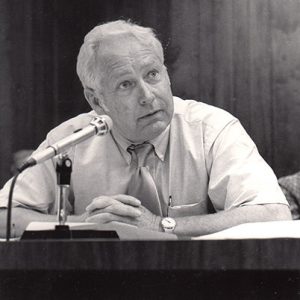calsfoundation@cals.org
Arkansas Prison Blood Scandal
The Arkansas prison blood scandal resulted from the state’s selling plasma extracted from prisoners at the Cummins Unit of the Arkansas Department of Correction (ADC). Corruption among the administrators of the prison blood program and poor supervision resulted in disease-tainted blood, often carrying hepatitis or HIV, knowingly being shipped to blood brokers, who in turn shipped it to Canada, Europe, and Asia. Revelation of the misdeeds and the healthcare crisis it created in Canada nearly brought down the Liberal Party government in 1997. In 1994, Arkansas became the last state to stop selling plasma extracted from prisoners.
Arkansas’s prison blood program began in 1964 as a way for both prisoners and the prison system to make money. (Arkansas law forbids paying prisoners for their labor.) Set up by Birmingham, Alabama, physician August R. Staugh, it was, from 1967 to 1978, managed at various times by a group of physicians from the University of Arkansas Medical Sciences Campus (now the University of Arkansas for Medical Sciences) in Little Rock (Pulaski County) and by the Department of Correction itself. In 1978, the state contracted with Health Management Associates Inc. (HMA), founded by pediatrician Francis “Bud” Henderson of Pine Bluff (Jefferson County), to run both the prison medical program and the plasma program. HMA sold each unit of plasma for fifty dollars, and the donating prisoner was usually paid seven dollars in scrip.
The problems with the prison plasma program were legion. Prisoners were not adequately screened for disease, and state investigators later confirmed allegations that some prisoners were not paid in cash but in drugs. Other misdeeds included an inmate clerk in the prison’s plasma center selling the “right to bleed” to fellow inmates who had been excluded because they likely were infected with hepatitis B (a possible indicator of HIV infection).
Many pharmaceutical companies ceased buying prison plasma after a December 1982 warning from the Food and Drug Administration (FDA) that prisoners were more likely than the general population to be infected with the AIDS virus. Despite this, HMA contracted with Continental Pharma Cryosan Ltd., Canada’s largest blood broker. Cryosan sold the plasma to companies in Europe and Japan and to Connaught Laboratories, a company based in Toronto, Ontario, that sold blood products needed by hemophiliacs throughout Canada. Only during a 1983 FDA-initiated international recall of plasma likely tainted with hepatitis B did Cryosan learn that it had been buying plasma extracted from prisoners. According to a report by the Krever Commission, which was established by the Canadian government in 1993 to investigate the blood scandal, “The shipping papers accompanying the plasma had not revealed that the centre was located in a prison. They had simply referred to the sources as the ‘ADC Plasma Center, Grady, Arkansas,’ without any indication that ‘ADC’ stood for ‘Arkansas Department of Correction.’” In 1984, the FDA revoked the license of the HMA plasma center after it had distributed hepatitis-contaminated plasma, though it managed to secure its license again after a few months.
In 1985, the Arkansas Board of Corrections hired the Institute for Law and Policy Planning (ILPP) in Berkeley, California, to conduct an independent investigation into HMA’s practices. At the same time, Governor Bill Clinton ordered the state police to conduct a similar investigation. The institute discovered instances in which HMA had violated its state contract in forty areas, including poor health assessment and recordkeeping and the hiring of unlicensed, uncertified, and unqualified staff. In contrast, the state police investigation found only that a few HMA employees had been running a small-time gambling operation. Clinton urged a swift end to the investigation. ADC director Art Lockhart, about whom many allegations of impropriety had been raised, was not punished; being an employee of the ADC board, he could not be fired by Clinton, and he had a protector in the powerful state Senator Knox Nelson of Pine Bluff.
HMA was able to retain its contract after the state police investigation partly because of the lobbying efforts of HMA’s president, Leonard Dunn, a Pine Bluff banker who later worked on Clinton’s 1990 gubernatorial campaign. His negotiations with the state resulted in the creation of an ombudsman position within HMA, which hired a Clinton-appointed judge, Richard Mays, for a two-year contract of $25,000. But after the critical ILPP report was released, HMA lost its contract and dissolved in 1986.
The contract then went to Pine Bluff Biologicals, which expanded the plasma program to other ADC units; at one time, prison plasma accounted for forty percent of the company’s business. But donor-screening problems persisted. In 1989, a prisoner who had been forbidden to donate on account of disease was able to sell plasma twenty-three times after he transferred from the Pine Bluff Diagnostics Unit to Cummins. The March 1991 edition of the Arkansas Times featured a story by Mara Leveritt on inmate plasma sales in Arkansas, raising the public’s awareness of the issue. In 1992, a series of state police investigations uncovered corruption in the prison plasma program, including allegations of nepotism, such as ADC director Lockhart’s asking Jimmy Lord, owner of Pine Bluff Biologicals, to hire his son. Lockhart was forced to resign.
The prison plasma program ended in 1994, but its effects linger. More than 1,000 Canadians who received plasma contaminated by that drawn from Arkansas prisoners were infected with HIV and 20,000 with hepatitis C. As a result of the report by Canadian Justice Horace Krever, that country’s Red Cross was stripped of its responsibility for the nation’s blood system; on May 30, 2005, the Canadian Red Cross pleaded guilty in Ontario Superior Court for its role in the scandal. As a result of a class-action lawsuit filed by more than 20,000 people who received tainted blood in Canada, the Canadian government, in late 1998, set aside a fund of $1.2 billion to compensate victims; on July 25, 2006, the Canadian government announced an expanded $875 million compensation package for victims. Arkansas has never apologized for its role in the blood scandal nor sought to reimburse victims for their suffering. Though some Canadians vowed to sue the Arkansas Department of Correction, no suit has yet materialized.
The Arkansas prison blood scandal was the subject of a novel, titled Blood Trail (1998), written by former HMA employee Mike Galster under the pseudonym Michael Sullivan. That same year, journalist Suzi Parker brought the story to greater national attention with an award-winning article she wrote for Salon.com. The scandal also has been the subject of a documentary movie, Factor 8: The Arkansas Prison Blood Scandal, directed by Kelly Duda, which was released in 2005 and drew worldwide attention to the events.
In England, Lord Peter Archer of Sandwell began, in March 2007, a public inquiry into contaminated blood given to British hemophilia patients in the 1970s and 1980s. At the beginning of the inquiry, the number of deaths from blood contaminated with hepatitis C and HIV in England stood at 1,757 out of over 6,000 infected; blood extracted from Arkansas prisoners has been linked to this contamination. The inquiry has heard testimony from victims, healthcare workers, investigative journalists (including filmmaker Duda), and more. Its final report cited a lack of self-sufficiency (being too much reliance on foreign sources of blood products) as the source of the problem. In July 2017, Prime Minister Theresa May announced the establishment of a full inquiry into these contaminated blood products. The British government began compensation payments of 100,000 pounds, only to those infected and their partners, in October 2022; these were considered interim payments as the full inquiry continued. In May 2024, the government announced that it would spend more than 10 billion pounds (or about $12.7 billion) compensating those affected.
For additional information:
Chase, Sophia. “The Bloody Truth: Examining America’s Blood Industry and Its Tort Liability through the Arkansas Prison Plasma Scandal.” William & Mary Business Law Review 3.2 (2012): 597–644. Online at https://scholarship.law.wm.edu/wmblr/vol3/iss2/6/ (accessed May 20, 2024).
Duda, Kelly, director. Factor 8: The Arkansas Prison Blood Scandal. Concrete Films, 2005.
Leveritt, Mara. “Blood Money.” Arkansas Times, March 1991, 34–39, 61–63.
———. “Bloody Awful.” Arkansas Times, August 16, 2007, pp. 12–14, 16.
———. “Bloody Trail Leads to Canada.” Arkansas Times, June 9, 1995, p. 9.
McCoogan, Cara. Blood Farm: The Explosive Big Pharma Scandal that Altered the AIDS Crisis. New York: Diversion Books, 2023.
Parker, Suzi. “Blood Money.” Salon, December 24, 1998. http://www.salon.com/1998/12/24/cov_23news/ (accessed October 2, 2023).
Reed, Jim. “HIV: How 175 British Children Were Infected with Disease.” BBC News, October 6, 2022. https://www.bbc.com/news/health-63080849 (accessed October 2, 2023).




 Bill Clinton
Bill Clinton  Knox Nelson
Knox Nelson 



Rainwater lawyers are NOT in the business of helping individuals. I have contacted them multiple times, and other big-name lawyers here in Arkansas for issues that are clear cut fault issues like neighbor dog attacking my child etc. I assume it is because the money isn’t there. I actually feel that there is no legal recourse available to common people unless they are thrust into defending themselves in court. I am sorry that happened to your father.
My dad received a complete blood transfusion in 1986 in a Little Rock, Arkansas, hospital. He became infected with Hep C as a result. How can Arkansas victims of contaminated blood be left to suffer and die in silence? As my dad lay in the bed hospice had provided he asked me, “You’ll get a lawyer? Won’t you, hun? Talk to Rainwater, hun. I know they’ll help. I didn’t have to be sick all this time.”